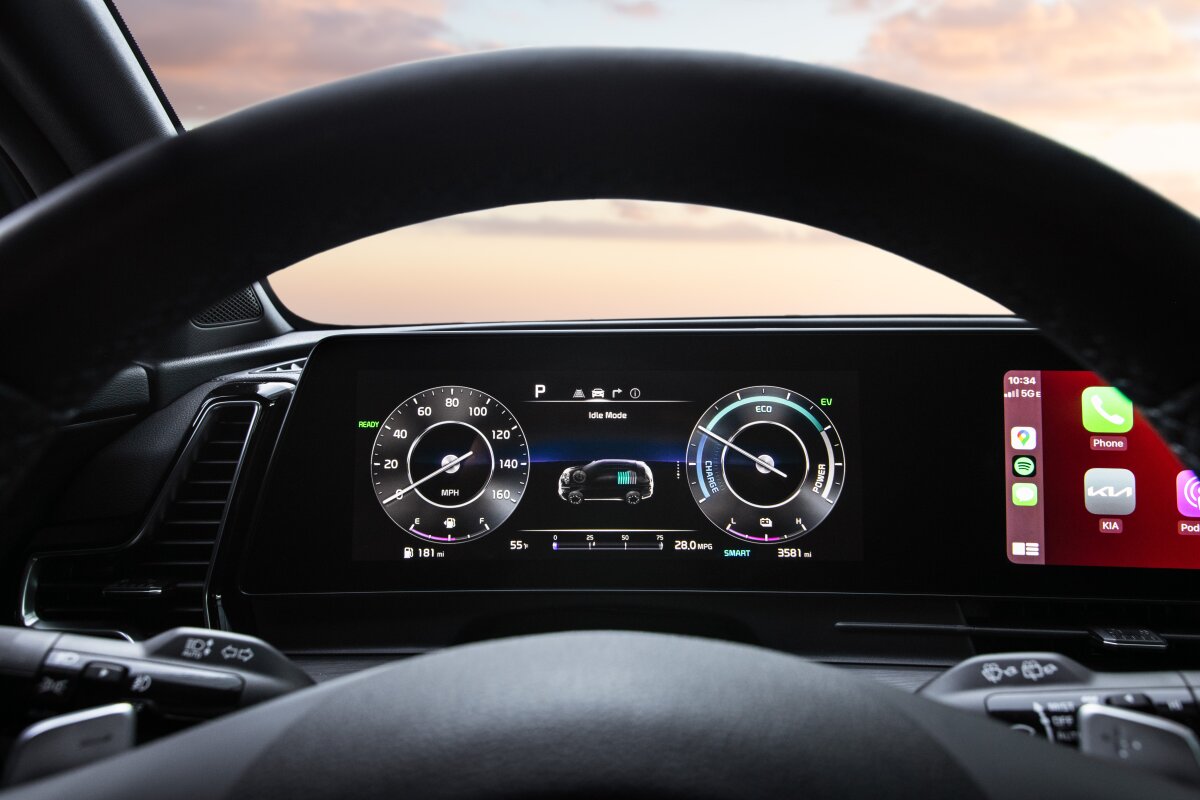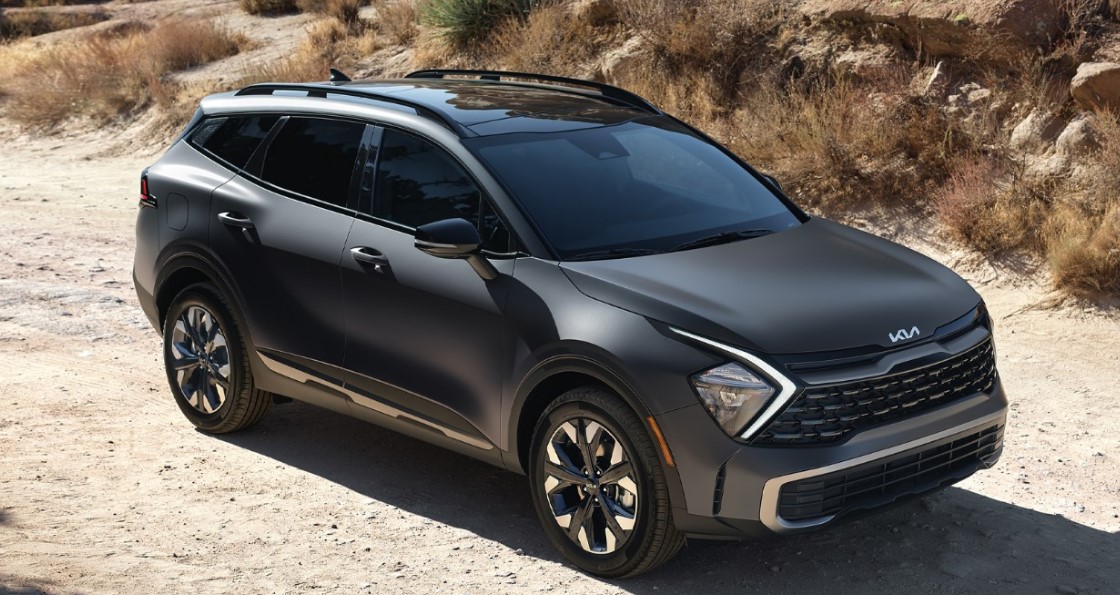Plug-in hybrids are ingenious things. Not so much because they can be driven entirely on battery power until they run low on charge – just like a vehicle that is powered entirely by a battery.
But because you don’t have to stop when the plug-in hybrid runs low on charge. You don’t even have to plug it in, if you prefer not to.
In brief, it cuts the cord that tethers the owner of a vehicle powered entirely by electricity – while providing some of the benefits of owning an electric vehicle, such as paying less and maybe even next to nothing for gas.
With a small catch.
What It Is
The Sportage is a compact-sized, two-row crossover one size down from Kia’s slightly larger (and three row) crossover, the Sorento.
It differs from the regular Sportage in two main ways. The first, of course, being that it has a plug-in hybrid drivetrain – which means it can be recharged without driving it. But also that you can just drive it. And for about 35 miles on battery power alone, if you start your drive with a fully charged battery.
The other difference is what it costs vs. the non-hybrid Sportage- which lists for $27,190 to start for the base LX trim. The plug-in Sportage starts at $39,690 for the X-Line trim and tops out at $44,190 for the X-Line Prestige trim.
Part of the price difference has to do with the plug-in’s more elaborate (and so, more expensive) drivetrain, which includes an engine and an electric motor plus a rechargeable battery pack (like an EV has) to store electricity to power the motor as well as some of the vehicle’s accessories – such as the AC and power steering – when the engine isn’t running. But the plug-in also starts out with more standard equipment, including synthetic leather seats with heaters, a panorama sunroof, a wireless charging pad and 12.3 inch combination main gauge cluster/secondary system interface.
The non-hybrid is available with the X-Line upgrades – but it comes standard without the panorama sunroof, with smaller (17 inch) wheels and smaller (and separated) main gauge and secondary infotainment displays.
It also doe not go 36 miles in city driving on a gallon of gas – and cannot be driven at all without burning at least some gas.
What’s New For 2025
The Sportage plug-in (which made its debut in 2023) carries over into 2025 unchanged.
What’s Good
Does not have to be plugged in. But can be plugged in.
About 35 miles of range on the batteries – and about 400 miles of range regardless.
Can tow almost as much as the non-hybrid Sportage.
What’s Not So Good
Not burning gas costs a lot of money.
Highway gas mileage (35 MPG) is essentially the same as the much less expensive non-hybrid Sportage’s (33 MPG).
Voice command interface for the audio system is technologically interesting but what happens when it glitches?
Under The Hood
The Sportage plug-in hybrid has one of the smallest, strongest and most fuel-efficient engines ever put in a two-ton-plus (4,229 lb.) vehicle. Just 1.6 liters – which is exactly the same size engine (and the same number of cylinders) that powered VW Beetles (the original, rear-engined ones) back in the ’70s. But the Beetle of the ’70s weighed half as much – and its 1.6 liter four cylinder engine didn’t produce 261 horsepower, which the Kia’s does.
Both do get about the same gas mileage, though.
The hybrid Kia rates 36 city, 35 highway – which is about what you’d get out of a ’70s Beetle if the engine was running right. And the Beetle needed to burn a gallon of gas to take you plus-or-minus 35 miles down the road.
The Kia doesn’t.
Not if its battery pack is fully charged up, which you can do by plugging it in to a 240V (household electric dryer-type) outlet. After about three hours, it’s ready to go – without burning any gas at all.
But the really ingenious thing is you don’t have to stop when it runs out of charge because there’s that 1.6 liter gas engine to keep you going (and charging the battery while you drive). The even more ingenious thing is you never have to plug it in – if you prefer not to. If you don’t, it will operate like a regular hybrid that alternates between engine on and engine off, with the engine cutting off when the vehicle isn’t moving or coasting/decelerating – but coming back on as needed to keep the vehicle moving.
And that’s really ingenious – because the plug-in hybrid layout enables car companies (not just Kia) to deliver what buyers want – which is a vehicle they can just drive, without having to plan for it or stop and wait before they can drive some more – while also paying lip service to the regulatory apparat’s regs that are being used to force off the market vehicles that aren’t “zero emissions.”
As if carbon dioxide were a pollutant and harmful in some way.
The beauty of the thing is that a plug-in hybrid is a “zero emissions” vehicle – just like an entirely electric vehicle – when its engine isn’t running. And so Kia gets credit for that absence of combustion – as well as for the absence of consumption. The Sportage rates 84 MPG”e” and that greatly fluffs up Kia’s CAFE (Corporate Average Fuel Economy) number, which – in turn – makes it more feasible for Kia to continue selling V6-powered vehicles such as the Telluride at prices regular people can still afford to pay.
But – again – there’s nothing that says the owner of a plug-in hybrid must plug it in. And the layout is such that the owner does not have to plug it in.
Now do you see the beauty of the thing?
Of course, there is a catch. It’s the cost. The least expensive version of the plug-in hybrid (the $39,960 X-line) costs $12,770 more than the least expensive version of the non-hybrid Sportage (the $27,190 LX). That is enough to buy gas enough to keep the non-hybrid Sportage going for about eight years before it begins to cost more to drive than the plug-in.
On the other hand, if you mostly don’t drive farther each day than the plug-in’s fully charged range, you might not burn much gas at all and so spend next-to-nothing on gas.
And there’s one more thing to take into consideration:
The plug-in version of Kia’s small crossover is – by far – the strongest/quickest version of the Sportage. The non-hybrid, with its 2.5 liter, 187 horsepower engine, takes more than 9 seconds to attain 60, which is among the slowest times posted by a small crossover in the class. The plug-in hybrid, with 261 horsepower available, knocks about 2 seconds off that time, getting there in just over 7 seconds.
And there’s another thing. This Kia has a conventional six speed automatic. It does not have a continuously variable (CVT) automatic, as probably two-thirds of non-hybrid small crossovers do have.
The plug-in Sportage can also pull as much as 2,000 lbs. – which is about 500 lbs. more than most small crossovers can handle.
On The Road
Driving an entirely electrically driven vehicle is different from driving a gas-engined vehicle because you’re necessarily having to pay close attention not just to the indicated range remaining but also how far it’s actually going. There is often a difference of 10-20 percent, indicated vs. actual – and that’s important when recovering range means stopping – and waiting – for a charge.
Because of how long that can take.
No such anxiety here. You can have the electric-drive experience without the electric drive experience. If the battery pack is fully charged, it’ll drive just like an EV until it isn’t anymore – at which point you can just keep on driving. You’ll only have to stop when the Kia runs low on gas – and then for the five minutes or less it takes to fully fuel it. The word is italicized to emphasize an important point about fully electric vehicles that is routinely not mentioned, which is that they cannot be fully charged at “fast” chargers.

At least, not “fast.”
They can only instill 80 percent charge “fast.” For safety (to reduce the risk of a fire caused by excessive heat build-up) and for the “health” (that is, longevity) of the battery, “fast” chargers have to trickle charge the remaining 20 percent – and that typically takes more than twice as long as it took to “fast” charge the 80 percent. So the time to “fill ‘er up” is not the “20-30 minutes” usually touted but more like an hour.
Most of us haven’t got time for that.
The plug-in layout eliminates the having to deal with that. Ever. This no doubt drives the weevils who infest the federal regulatory apparat who have been pushing “zero emissions” EVs batty. Never mind that a plug-in vehicle’s “emissions” are nearly zero. It’s never enough for the weevils – because it’s not about the “emissions.” It’s about using “emissions” as the excuse to push people into vehicles that are an expensive hassle to own. That tether them to a cord. They are already complaining that owners of plug-in hybrids aren’t plugging them in often enough.

Probably because they’d rather be driving somewhere.
This Kia is also more pleasant to drive than others of its type – and generally – because of its conventional six speed automatic, which shifts through its six speeds. This just feels (and sounds) better than a CVT automatic that varies its ranges. CVT trannies often feel like they’re slipping, because the engine will run at high RPM when you push down hard on the gas pedal and stay there, until you ease off. This also makes a lot of racket. You don’t get that – or the slipping feel – here.
Otherwise, it’s pretty much the typical medium-small crossover experience. This is a compliment. The plug-in Sportage feels and sounds pretty much normal, with the exception of the silent running when it’s operating under electric power. That can be fun, too – because you don’t have to worry about it.

At The Curb
They all look the same – so goes the usual lament about crossovers, hybrid and not. And that’s true. Kia tried to make the Sportage look different – from the front (and rear) at least. How it looks is a matter of taste – but it does look different!
The rest of the shape is more conventional-looking because it pretty much has to be. The reason most crossovers have the same basic shape (snd so, look) is because function dictates form. If you want to maximize the interior space of a vehicle – especially one with a small footprint – then it’s going to look a certain way, irrespective of make or model.

So – the front and rear ends excepted – the Sportage is shaped like others of its type so as to have class-competitive cargo space behind its second row (34.5 cubic feet) and with its second row folded (65.5 cubic feet). The Honda CR-V has more space – 39.3 cubic feet behind its second row and 76.5 cubic feet total – but it is not available with a plug-in drivetrain and it comes standard with a CVT transmission. The Toyota RAV4 has about the same cargo space as the Kia (33.5 cubic feet behind its second row and 64.8 total cubic feet and it’s available with a plug-in hybrid drivetrain that can take you 42 miles on battery power. It’s advertised 42 city, 36 highway mileage also beats the Kia. But it comes with a CVT transmission – and its base price of $43,690 is $4,000 higher than the Kia’s.

The regular (non-hybrid) Sportage is available in seven different trims – including the value-priced LX and EX. The plug-in hybrid comes in just two X-line trims that are essentially top-of-the-line trims. That means pretty much everything that costs extra with the non-hybrid is standard equipment in the plug-in. Including a fancier, one-piece flatscreen dash display that’s very similar to the ones that first appeared about ten years ago in the highest-end luxury-brand vehicles.
This may be a Kia but it looks as fancy inside as any current luxury-brand vehicle. If it offered massaging seats, it would be as fancy as any current-brand luxury vehicle.
The Rest

Why doesn’t Kia offer a base-trim version of the plug-in that does not come standard with such things as a one-piece flatscreen display, heated leather seats (and steering wheel), LED lights, a panorama roof and all of the other nice-to-have but cost-adding amenities – which make the Sportage plug-in cost so much that whatever you might “save” on gas is a kind of financial non sequitur?
Maybe because Kia’s trying to market this vehicle similarly to the way most electric-only vehicles are marketed; i.e., on the basis of performance and luxury more so than economy.
Toyota does the same, by the way – and to an even more costly degree.
It’d be nice if it weren’t so expensive to save money on gas.
The Bottom Line
If you are interested in an electric-drive car that doesn’t cost you time – and hassle – a part-time electric car might be the right car for you.
. . .
If you like what you’ve found here please consider supporting EPautos.
PS: Get an EPautos magnet or sticker or coaster in return for a $20 or more one-time donation or a $10 or more monthly recurring donation. (Please be sure to tell us you want a magnet or sticker or coaster – and also, provide an address, so we know where to mail the thing!)
If you like items like the Baaaaaa! baseball cap pictured below, you can find that and more at the EPautos store!


